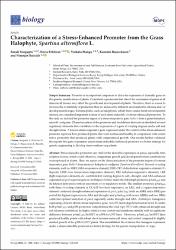| dc.contributor.author | Sengupta, Sonali | |
| dc.contributor.author | Pehlivan, Necla | |
| dc.contributor.author | Mangu, Venkata | |
| dc.contributor.author | Rajasekaran, Kanniah | |
| dc.contributor.author | Baisakh, Niranjan | |
| dc.date.accessioned | 2023-03-21T07:40:19Z | |
| dc.date.available | 2023-03-21T07:40:19Z | |
| dc.date.issued | 2022 | en_US |
| dc.identifier.citation | Sengupta, S., Pehlivan, N., Mangu, V., Rajasekaran, K., & Baisakh, N. (2022). Characterization of a Stress-Enhanced Promoter from the Grass Halophyte, Spartina alterniflora L. Biology, 11(12), 1828. https://doi.org/10.3390/biology11121828 | en_US |
| dc.identifier.issn | 2079-7737 | |
| dc.identifier.issn | 2079-7737 | |
| dc.identifier.uri | https://doi.org/10.3390/biology11121828 | |
| dc.identifier.uri | https://hdl.handle.net/11436/7938 | |
| dc.description.abstract | Stress-inducible promoters are vital for the desirable expression of genes, especially transcription factors, which could otherwise compromise growth and development when constitutively
overexpressed in plants. Here, we report on the characterization of the promoter region of a stressresponsive gene SaAsr1 from monocot halophyte cordgrass (Spartina alterniflora). Several cis-acting
elements, such as ABRE (ABA-responsive element), DRE-CRT (dehydration responsive-element/CRepeat), LTRE (low temperature-responsive element), ERE (ethylene-responsive element), LRE
(light-responsive element), etc. contributed at varying degrees to salt-, drought- and ABA-enhanced
expression of gusA reporter gene in Arabidopsis thaliana under the full-length promoter, pAsr11875 and
its deletion derivatives with an assortment of cis-regulatory motifs. The smallest promoter, pAsr1491,
with three cis-acting elements (a CCAAT box-heat responsive, an LRE, and a copper responsive
element) conferred drought-enhanced expression of gusA; pAsr1755 (with an ABRE and a DRE) presented the highest expression in ABA and drought; and pAsr1994 with seven ABREs and two DREs
conferred optimal induction of gusA, especially under drought and ABA. Arabidopsis transgenics
expressing a known abiotic stress-responsive gene, SaADF2 (actin depolymerization factor 2), under
both pAsr11875 and p35S promoters outperformed the wild type (WT) with enhanced drought and
salt tolerance contributed by higher relative water content and membrane stability with no significant
difference between pAsr11875:SaADF2 or p35S:SaADF2 lines. However, pAsr11875:SaADF2 lines
produced healthy plants with robust shoot systems under salt stress and control compared to slightly
stunted growth of the p35S:SaADF2 plants. This reestablished the evidence that transgene expression
under a stress-inducible promoter is a better strategy for the genetic manipulation of crops. | en_US |
| dc.language.iso | eng | en_US |
| dc.rights | info:eu-repo/semantics/openAccess | en_US |
| dc.subject | Abiotic stress | en_US |
| dc.subject | Genetic engineering | en_US |
| dc.subject | Halophyte | en_US |
| dc.subject | Promoter | en_US |
| dc.subject | Stress-inducible | en_US |
| dc.title | Characterization of a Stress-Enhanced Promoter from the Grass Halophyte, Spartina alterniflora L. | en_US |
| dc.type | article | en_US |
| dc.contributor.department | RTEÜ, Fen - Edebiyat Fakültesi, Biyoloji Bölümü | en_US |
| dc.contributor.institutionauthor | Pehlivan, Necla | |
| dc.identifier.doi | 10.3390/biology11121828 | en_US |
| dc.identifier.volume | 11 | en_US |
| dc.identifier.issue | 22 | en_US |
| dc.identifier.startpage | 1828 | en_US |
| dc.relation.journal | Biology | en_US |
| dc.relation.publicationcategory | Makale - Uluslararası Hakemli Dergi - Kurum Öğretim Elemanı | en_US |


















